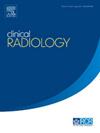使用多能计算机断层扫描(CT)数据训练的深度学习模型显示腰部CT成像的金属伪影减少效果更好。
IF 1.9
3区 医学
Q2 RADIOLOGY, NUCLEAR MEDICINE & MEDICAL IMAGING
引用次数: 0
摘要
目的:研究基于虚拟单色图像(VMIs)在多能级和单能级下基于深度学习的金属伪影还原(deep-MAR)模型,并比较其在更宽能级下的性能。材料和方法:我们招募了93例腰椎植入物患者,他们接受了多能CT扫描,然后在70和100 keV的能量水平下重建成VMIs(随机选择10例,能量水平从40到140 keV)。以modelMAR处理后的原始图像作为建立的参考。使用70 KeV、100 KeV和两个能级(model70、model100和modelmix)的不同数据集训练深度mar模型。然后,采用三种深度mar模型对原始图像进行处理,计算峰值信噪比(PSNR)和结构相似指数(SSIM)。并对所有处理后的图像进行客观和主观图像质量的比较。结果:在40 ~ 140 keV范围内,混合模型的PSNR和SSIM与70和100模型相当或更高。对于衰减校正,modelmix在70 keV水平下优于model100, model70在100 keV水平下优于model70 (P0.050)。同时,3种深度- mar模型在100 keV水平下的椎管图像噪声均低于modelMAR模型(p)。结论:在更宽的能量水平下,图像质量更好,建议在深度- mar模型训练中纳入多能量CT数据用于术后腰椎CT扫描。本文章由计算机程序翻译,如有差异,请以英文原文为准。
Deep learning model trained using multi-energy computed tomography (CT) data shows better metal artifact reduction for lumbar CT imaging
AIM:
To develop different deep learning–based metal artifact reduction (MAR) models (deep-MAR) based on virtual monochromatic images (VMIs) at both multiple energy levels and single-energy level, and compare their performance under wider energy levels.
MATERIALS AND METHODS
We enrolled 93 patients with lumbar implants who underwent multi-energy CT scans and then reconstructed into VMIs at energy levels of 70 and 100 keV (10 randomly selected cases at levels ranging from 40 to 140 keV). Original images processed by modelMAR were served as the established reference. Deep-MAR models were trained using diverse datasets at energy levels of 70 KeV, 100 KeV, and two levels (model70, model100, and modelmix). Afterwards, original images were processed using three deep-MAR models, and peak signal-to-noise ratio (PSNR) and structural similarity index (SSIM) were calculated. Objective and subjective image qualities of all processed images were also compared.
RESULTS
From 40 to 140 keV, PSNR and SSIM of modelmix were comparable to or higher than those of model70 and model100. For attenuation correction, modelmix performed better than model100 at 70 keV level and model70 at 100 keV level (P<0.010) but comparably to modelMAR at both levels (P>0.050). Meanwhile, image noise in the spinal canal of three deep-MAR models at 100 keV level were lower than these of modelMAR (P<0.010). The scores of subjective image quality for modelmix were comparable to or higher than those of model70 and model100.
CONCLUSION
With better image quality across broader energy levels, multiple energy CT data are recommended to be comprised in the training of deep-MAR model for postoperative lumbar CT scanning.
求助全文
通过发布文献求助,成功后即可免费获取论文全文。
去求助
来源期刊

Clinical radiology
医学-核医学
CiteScore
4.70
自引率
3.80%
发文量
528
审稿时长
76 days
期刊介绍:
Clinical Radiology is published by Elsevier on behalf of The Royal College of Radiologists. Clinical Radiology is an International Journal bringing you original research, editorials and review articles on all aspects of diagnostic imaging, including:
• Computed tomography
• Magnetic resonance imaging
• Ultrasonography
• Digital radiology
• Interventional radiology
• Radiography
• Nuclear medicine
Papers on radiological protection, quality assurance, audit in radiology and matters relating to radiological training and education are also included. In addition, each issue contains correspondence, book reviews and notices of forthcoming events.
 求助内容:
求助内容: 应助结果提醒方式:
应助结果提醒方式:


